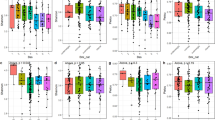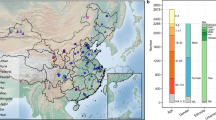Abstract
Trillions of microorganisms inhabit the human gut and are regarded as potential key factors for health1,2. Characteristics such as diet, lifestyle, or genetics can shape the composition of the gut microbiota2,3,4,5,6 and are usually shared by individuals from comparable ethnic origin. So far, most studies assessing how ethnicity relates to the intestinal microbiota compared small groups living at separate geographical locations7,8,9,10. Using fecal 16S ribosomal RNA gene sequencing in 2,084 participants of the Healthy Life in an Urban Setting (HELIUS) study11,12, we show that individuals living in the same city tend to share similar gut microbiota characteristics with others of their ethnic background. Ethnicity contributed to explain the interindividual dissimilarities in gut microbiota composition, with three main poles primarily characterized by operational taxonomic units (OTUs) classified as Prevotella (Moroccans, Turks, Ghanaians), Bacteroides (African Surinamese, South-Asian Surinamese), and Clostridiales (Dutch). The Dutch exhibited the greatest gut microbiota α-diversity and the South-Asian Surinamese the smallest, with corresponding enrichment or depletion in numerous OTUs. Ethnic differences in α-diversity and interindividual dissimilarities were independent of metabolic health and only partly explained by ethnic-related characteristics including sociodemographic, lifestyle, or diet factors. Hence, the ethnic origin of individuals may be an important factor to consider in microbiome research and its potential future applications in ethnic-diverse societies.
This is a preview of subscription content, access via your institution
Access options
Access Nature and 54 other Nature Portfolio journals
Get Nature+, our best-value online-access subscription
$29.99 / 30 days
cancel any time
Subscribe to this journal
Receive 12 print issues and online access
$209.00 per year
only $17.42 per issue
Buy this article
- Purchase on Springer Link
- Instant access to full article PDF
Prices may be subject to local taxes which are calculated during checkout



Similar content being viewed by others
References
Schroeder, B. O. & Bäckhed, F. Signals from the gut microbiota to distant organs in physiology and disease. Nat. Med. 22, 1079–1089 (2016).
Lynch, S. V. & Pedersen, O. The human intestinal microbiome in health and disease. N. Engl. J. Med. 375, 2369–2379 (2016).
Findley, K., Williams, D. R., Grice, E. A. & Bonham, V. L. Health disparities and the microbiome. Trends Microbiol. 24, 847–850 (2016).
Zhernakova, A. et al. Population-based metagenomics analysis reveals markers for gut microbiome composition and diversity. Science 352, 565–569 (2016).
Falony, G. et al. Population-level analysis of gut microbiome variation. Science 352, 560–564 (2016).
Goodrich, J. K. et al. Human genetics shape the gut microbiome. Cell 159, 789–799 (2014).
Gupta, V. K., Paul, S. & Dutta, C. Geography, ethnicity or subsistence-specific variations in human microbiome composition and diversity. Front. Microbiol. 8, 1162 (2017).
Miller, G. E. et al. Lower neighborhood socioeconomic status associated with reduced diversity of the colonic microbiota in healthy adults. PLoS One 11, e0148952 (2016).
Huttenhower, C. et al. Structure, function and diversity of the healthy human microbiome. Nature 486, 207–214 (2012).
Rothschild, D. et al. Environment dominates over host genetics in shaping human gut microbiota. Nature 555, 210–215 (2018).
Stronks, K. et al. Unravelling the impact of ethnicity on health in Europe: the HELIUS study. BMC Public Health 13, 402 (2013).
Snijder, M. B. et al. Cohort profile: the Healthy Life in an Urban Setting (HELIUS) study in Amsterdam, The Netherlands. BMJ Open 7, e017873 (2017).
Yatsunenko, T. et al. Human gut microbiome viewed across age and geography. Nature 486, 222–227 (2012).
Schnorr, S. L. et al. Gut microbiome of the Hadza hunter-gatherers. Nat. Commun. 5, 3654 (2014).
Bouter, K. E., van Raalte, D. H., Groen, A. K. & Nieuwdorp, M. Role of the gut microbiome in the pathogenesis of obesity and obesity-related metabolic dysfunction. Gastroenterology 152, 1671–1678 (2017).
Sonnenburg, J. L. & Bäckhed, F. Diet–microbiota interactions as moderators of human metabolism. Nature 535, 56–64 (2016).
De Filippo, C. et al. Diet, environments, and gut microbiota. A preliminary investigation in children living in rural and urban Burkina Faso and Italy. Front. Microbiol. 8, 1979 (2017).
Beaumont, M. et al. Heritable components of the human fecal microbiome are associated with visceral fat. Genome Biol. 17, 189 (2016).
Le Chatelier, E. et al. Richness of human gut microbiome correlates with metabolic markers. Nature 500, 541–546 (2013).
Stenman, L. K., Burcelin, R. & Lahtinen, S. Establishing a causal link between gut microbes, body weight gain and glucose metabolism in humans—towards treatment with probiotics. Benef. Microbes 7, 11–22 (2016).
Oki, K. et al. Comprehensive analysis of the fecal microbiota of healthy Japanese adults reveals a new bacterial lineage associated with a phenotype characterized by a high frequency of bowel movements and a lean body type. BMC Microbiol. 16, 284 (2016).
Goodrich, J. K. et al. Genetic determinants of the gut microbiome in UK twins. Cell Host Microbe 19, 731–743 (2016).
Qin, J. et al. A metagenome-wide association study of gut microbiota in type 2 diabetes. Nature 490, 55–60 (2012).
Lippert, K. et al. Gut microbiota dysbiosis associated with glucose metabolism disorders and the metabolic syndrome in older adults. Benef. Microbes 8, 545–556 (2017).
Luthold, R. V., Fernandes, G. R., Franco-de-Moraes, A. C., Folchetti, L. G. D. & Ferreira, S. R. G. Gut microbiota interactions with the immunomodulatory role of vitamin D in normal individuals. Metabolism. 69, 76–86 (2017).
Arumugam, M. et al. Enterotypes of the human gut microbiome. Nature 473, 174–180 (2011).
Knights, D. et al. Rethinking “enterotypes”. Cell Host Microbe 16, 433–437 (2014).
Wu, G. D. et al. Linking long-term dietary patterns with gut microbial enterotypes. Science 334, 105–108 (2011).
Tremaroli, V. & Bäckhed, F. Functional interactions between the gut microbiota and host metabolism. Nature 489, 242–249 (2012).
Jones, B. V., Begley, M., Hill, C., Gahan, C. G. M. & Marchesi, J. R. Functional and comparative metagenomic analysis of bile salt hydrolase activity in the human gut microbiome. Proc. Natl. Acad. Sci. 105, 13580–13585 (2008).
Nakayama, J. et al. Diversity in gut bacterial community of school-age children in Asia. Sci. Rep. 5, 8397 (2015).
Fortenberry, J. D. The uses of race and ethnicity in human microbiome research. Trends Microbiol. 21, 165–166 (2013).
Costello, E. K., Stagaman, K., Dethlefsen, L., Bohannan, B. J. M. & Relman, D. A. The application of ecological theory toward an understanding of the human microbiome. Science 336, 1255–1262 (2012).
Walter, J. & Ley, R. The human gut microbiome: ecology and recent evolutionary changes. Annu. Rev. Microbiol. 65, 411–429 (2011).
Prideaux, L. et al. Impact of ethnicity, geography, and disease on the microbiota in health and inflammatory bowel disease. Inflamm. Bowel Dis. 19, 2906–2918 (2013).
Borgdorff, H. et al. The association between ethnicity and vaginal microbiota composition in Amsterdam, the Netherlands. PLoS One 12, e0181135 (2017).
Hellenthal, G. et al. A genetic atlas of human admixture history. Science 343, 747–751 (2014).
Stronks, K., Kulu-Glasgow, I. & Agyemang, C. The utility of ‘country of birth’ for the classification of ethnic groups in health research: the Dutch experience. Ethn. Health 14, 255–269 (2009).
Dekker, L. H. et al. A prospective cohort study of dietary patterns of non-western migrants in the Netherlands in relation to risk factors for cardiovascular diseases: HELIUS-Dietary Patterns. BMC Public Health 11, 441 (2011).
Beukers, M. H. et al. Development of the HELIUS food frequency questionnaires: ethnic-specific questionnaires to assess the diet of a multiethnic population in The Netherlands. Eur. J. Clin. Nutr. 69, 579–584 (2015).
Mobini, R. et al. Metabolic effects of Lactobacillus reuteri DSM 17938 in people with type 2 diabetes: a randomized controlled trial. Diabetes Obes. Metab. 19, 579–589 (2017).
Kozich, J. J., Westcott, S. L., Baxter, N. T., Highlander, S. K. & Schloss, P. D. Development of a dual-index sequencing strategy and curation pipeline for analyzing amplicon sequence data on the MiSeq Illumina sequencing platform. Appl. Environ. Microbiol. 79, 5112–5120 (2013).
Andrews, S. FastQC: a Quality Control Tool for High Throughput Sequence Data http://www.bioinformatics.babraham.ac.uk/projects/fastqc (2010).
Schloss, P. D. et al. Introducing mothur: open-source, platform-independent, community-supported software for describing and comparing microbial communities. Appl. Environ. Microbiol. 75, 7537–7541 (2009).
Edgar, R. C. Search and clustering orders of magnitude faster than BLAST. Bioinformatics 26, 2460–2461 (2010).
Rognes, T., Flouri, T., Nichols, B., Quince, C. & Mahé, F. VSEARCH: a versatile open source tool for metagenomics. PeerJ 4, e2584 (2016).
Price, M. N., Dehal, P. S. & Arkin, A. P. FastTree 2—approximately maximum-likelihood trees for large alignments. PLoS One 5, e9490 (2010).
Oksanen, J et al. vegan: Community Ecology Package https://CRAN.R-project.org/package=vegan (2017).
McMurdie, P. J. & Holmes, S. phyloseq: an R Package for reproducible interactive analysis and graphics of microbiome census data. PLoS One 8, e61217 (2013).
World Health Organization. Physical status: the use and interpretation of anthropometry. Report of a WHO expert committee 854, 1–452 (1995).
Langille, M. G. I. et al. Predictive functional profiling of microbial communities using 16S rRNA marker gene sequences. Nat. Biotechnol. 31, 814–821 (2013).
Acknowledgements
The authors thank R. Jakubowicz and M. Krämer for DNA extraction, PCR amplification, and sequencing. The HELIUS study is conducted by the AMC Amsterdam and the Public Health Service of Amsterdam. Both organizations provided core support for HELIUS. The HELIUS study is also funded by the Dutch Heart Foundation, the Netherlands Organization for Health Research and Development (ZonMw), the European Union (FP-7), and the European Fund for the Integration of non-EU immigrants (EIF). We gratefully acknowledge the AMC Biobank for their support in biobank management and high-quality storage of collected samples. We are most grateful to the participants of the HELIUS study and the management team, research nurses, interviewers, research assistants and other staff who have taken part in gathering the data of this study. The study reported here was additionally supported by Le Ducq consortium grant 17CVD01 to M. Nieuwdorp and F.B., JPI-HDHL MICRODIET consortium grant to M. Nieuwdorp and F.B., on which I.A. is appointed, and Novo Nordisk Foundation Gut-MMM grant to M. Nieuwdorp and F.B. M. Nieuwdorp is supported by a personal ZONMW-VIDI grant 2013 (016.146.327), on which G.J.B. is appointed, and a Dutch Heart Foundation CVON IN CONTROL Young Talent Grant 2013, on which A.P. is appointed. F.B. is Torsten Söderberg Professor in Medicine and recipient of a European Research Council Consolidator Grant (615362— METABASE). D.H.V.R. is supported by a junior fellowship of the Dutch Diabetes Foundation (2015.81.1840) and by a Marie Skłodowska-Curie Actions global fellowship (708193). The funders had no role in the study design, the collection, analysis, and interpretation of data, the writing of the report, and the decision to submit the article for publication.
Author information
Authors and Affiliations
Contributions
M.D. analyzed and interpreted the data and drafted the manuscript (M. Nieuwdorp supervised). M. Nieuwdorp, F.B., A.H.Z., R.P., M. Nicolaou, M.B.S., V.T., G.J.B., A.P., and E.L. contributed to the acquisition of the data. K.E.B., A.P., E.L., A.K.G., H.H., V.T., G.J.B., I.A., S.-J.P.-S., D.H.V.R., M.B.S., M. Nicolaou, R.P., A.H.Z., and F.B. contributed to data interpretation and critically reviewed the manuscript. All authors had access to the study data, and reviewed and approved the final manuscript.
Corresponding authors
Ethics declarations
Competing interests
M. Nieuwdorp sits on the Scientific Advisory Board of Caelus Health, The Netherlands; F.B. sits on the Scientific Advisory Board of MetaboGen AB, Sweden. Neither of these are directly relevant to the current paper. There are no patents, products in development, or marketed products to declare. The other authors declare no competing financial interests.
Additional information
Publisher’s note: Springer Nature remains neutral with regard to jurisdictional claims in published maps and institutional affiliations.
Supplementary information
Supplementary Text and Figures
Supplementary Figures 1–8
Supplementary Table 1
Characteristics of participants
Supplementary Table 2
OTU, genus and phylum composition across ethnic groups
Supplementary Table 3
Associations between the characteristics of participants and α- and β-diversity
Supplementary Table 4
Gut microbiota α-diversity across ethnic groups
Supplementary Table 5
Dietary pattern loadings, scores and associated nutrient and food group intakes
Supplementary Table 6
PICRUSt-derived functional profile across ethnic groups
Supplementary Table 7
Taxonomy classification and representative sequences of the OTUs
Rights and permissions
About this article
Cite this article
Deschasaux, M., Bouter, K.E., Prodan, A. et al. Depicting the composition of gut microbiota in a population with varied ethnic origins but shared geography. Nat Med 24, 1526–1531 (2018). https://doi.org/10.1038/s41591-018-0160-1
Received:
Accepted:
Published:
Issue Date:
DOI: https://doi.org/10.1038/s41591-018-0160-1
This article is cited by
-
Ethnic variations in metabolic syndrome components and their associations with the gut microbiota: the HELIUS study
Genome Medicine (2024)
-
A case–control study of the association between the gut microbiota and colorectal cancer: exploring the roles of diet, stress, and race
Gut Pathogens (2024)
-
Microbial-derived imidazole propionate links the heart failure-associated microbiome alterations to disease severity
Genome Medicine (2024)
-
The microbiome as a determinant of racial and ethnic cancer disparities
Nature Reviews Cancer (2024)
-
Differences in gut microbiota between Dutch and South-Asian Surinamese: potential implications for type 2 diabetes mellitus
Scientific Reports (2024)



